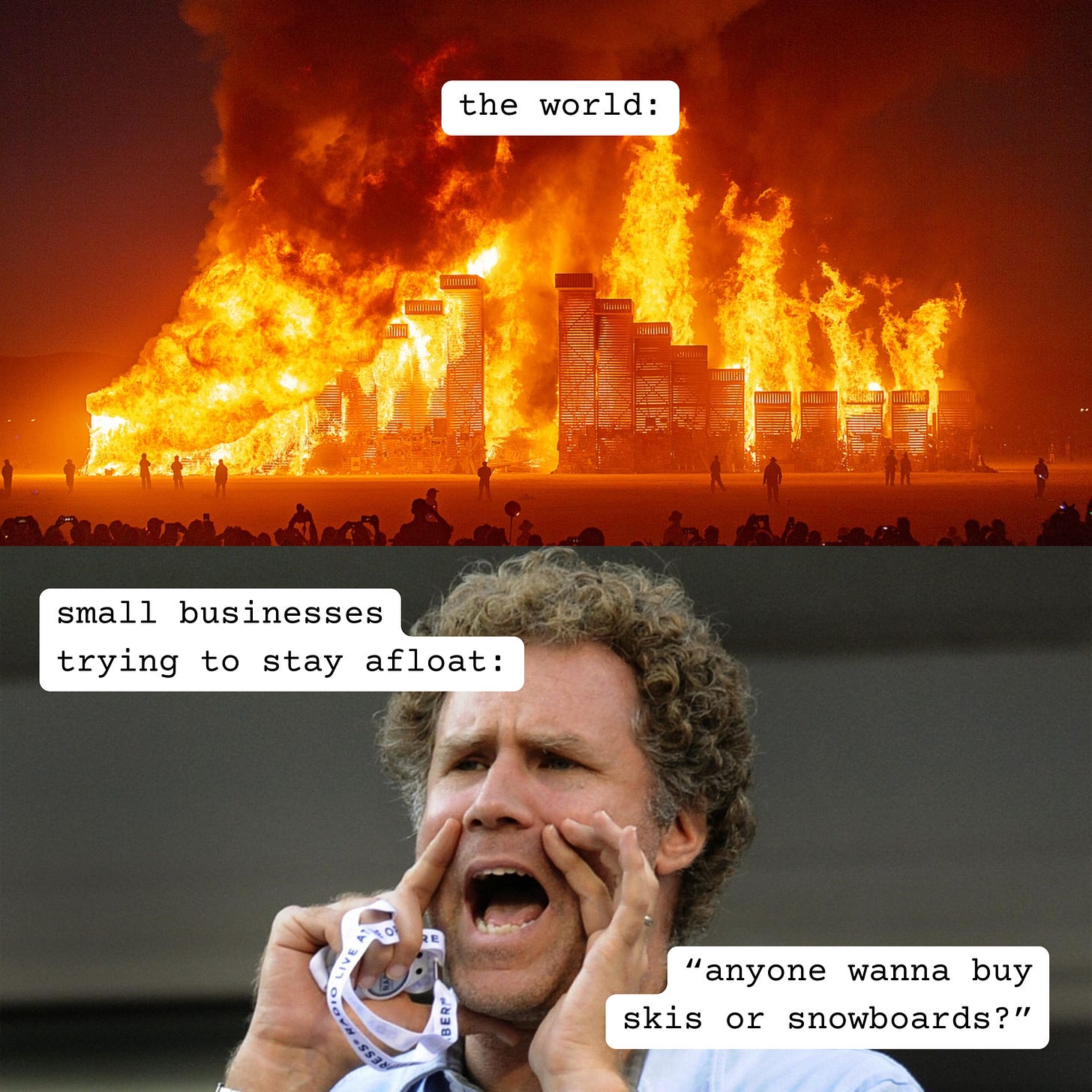Years ago, I would have screamed into my pillow after reading an email like the one I received last week. Not anymore. I want to tell you it’s because I meditate every morning and repeat the mantra “I’m not my business,” but I’d be lying. I’m not very good at meditating or mantras, but I do know how to read the headlines, and those, paired with the relentless onslaught of challenges small business owners like me have faced since the pandemic, leave you in a state that only memes can accurately depict.
Did they leave me on read?
In February, I emailed Coalition’s US-based manufacturer, as I do every year, to have samples of the two snowboards they make pressed for the following season. It’s standard practice in the industry to request samples for photo shoots and to check the graphics. That email, and the subsequent ones sent through April, were left unanswered.
At the same time, I was sending emails to our wholesale partners at REI, Backcountry, and evo, asking how other brands and the industry in general planned to manage tariffs. Early in January, there seemed to be a perception that only brands manufacturing in Asia would be hit hard, which felt a bit like burying one’s head in the sand, for a number of reasons.
First, supply chains in the outdoor industry are complex—you can manufacture in the United States, but many materials, particularly technical materials found in outdoor goods, are imported from China. The raw materials simply are not available in the United States. Second, the King was quite clear that he would impose tariffs on any country with which the US found itself in a trade deficit. While the reciprocal tariffs announced on “Kill Small Businesses Day” on April 2nd have been temporarily paused, the damage has been done—consumer confidence is at an all-time low, sales are down, businesses have reduced or ceased production and importing, and recession fears have spiked.
People have been quite skeptical of my doomsday analysis of the tariffs. But here’s the thing: I know too much. I’ve been manufacturing and importing for more than a decade. I am friends with dozens of small businesses, many of whom manufacture. And there are dozens more who work in the outdoor industry for big and small brands, and we all talk. I also diligently follow the news and follow the reporting from the trade organizations2. The average consumer doesn’t understand how dire the situation is (no shade, just fact)—shelves will soon be empty and prices are going to skyrocket, and it not just in the outdoor industry. That’s why I wasn’t surprised to read the email from our US-based manufacturer: Due to increasing costs and uncertain tariffs, they would not be able to produce for us any longer.
The myth of US manufacturing
I love the idea of robust manufacturing in the United States. Perhaps with government grants, adequate workforce training, and a decade to get it dialed to the point where the products won’t fall apart, it would be viable. But as it stands today, there is no tariff or embargo on China that will poof, miraculously facilitate US manufacturing. We don’t have access to the raw materials, the tooling and machinery do not exist, and the workforce either is not trained or very expensive. I suppose the latter is why Republicans are rolling back child labor laws—they know hiring Americans will skyrocket the cost of goods and they’re deporting the people who will work for pennies.
Despite all of this, I have tried to manufacture in the United States on more than one occasion. We designed three skis—one of which in partnership with an Olympian who competed on them at 2018 Winter Olympics—and two more, the Rafiki and La Nieve, that we still sell today. All of our research, design, and manufacturing took place in the US until our manufacturer closed up shop back in 2021 after our nation’s last big economic downturn. I approached a handful of manufacturers in the US, but their pricing would have forced us to retail our skis for more than $1,000 and they did not have the capacity to manufacture our entire line.
So I did what any reasonable business owner would do—I built the molds with our existing Asian factory, which is owned and operated by a third-generation Japanese family that has been highly decorated by the Japanese government. Part of our mission at Coalition is to make skiing and snowboarding accessible, so maintaining prices and selection is core to our model, and it’s non-negotiable for me.
Clearly, I’m a glutton for punishment. We still attempted to manufacture in the US, building two more technical snowboards, a powder board and a splitboard, with another domestic factory. The cost—a jaw-dropping 500% more than our manufacturing in Asia. It’s why those snowboards cost $200 to $400 more. Not surprisingly, we didn’t sell that many. But for all the reasons from supporting American workers to making manufacturing viable in the United States, I wanted to manufacture here, so I took a big hit on those two snowboards for years. And I would have kept doing it until our builders told us it wasn’t feasible anymore.
As explained by the really nice guys who just want to make snowboards in Lake Tahoe for a living, the cost of materials is so expensive, and their labor so valuable, that they would have to charge us more than $800 for a finished product. We would have to pass that onto the consumer for a minimum of $1,200 but healthy margins would demand at least $1,600. Here’s the kicker: They aren’t certain on that price because no one knows how tariffs will impact the import of raw materials required to build skis and snowboards. It’s $800 today, but what if it’s $1,000 in a few months?
It’s this lack of predictability that is making business impossible.
We have run our businesses through COVID, Black Lives Matter, #MeToo, #TimesUp, two Trump presidencies, war, and genocide. And wouldn’t you know it, all of those things impact consumer confidence, manufacturing costs, shipping costs, cost of goods, discretionary spending, and wages. But not in any understandable way.
There was a time when you could look at previous years’ sales and expenses and project what they would be in the following years with relative clarity. It wasn’t perfect, but it helped you plan. Now we are flying by the seat of our pants, swapping out detailed financials with cocktail napkin-style calculations that track cash flow because the accuracy of the former became laughable.
One day there are 10% tariffs. The next day there's reciprocal tariffs. JK Liberation Day didn't work out the way they planned so there's a 90-day pause. But not in China. But then there's maybe a deal with China six weeks later? What's going to happen over the next 90 days? The lack of clarity and strategy is disastrous. And the damage has been done.
I’m not special
A decade of manufacturing a selection of our goods in the US has come to an end. It is not possible to find another factory, make the molds, and manufacture in time for the 25/26 season. My overseas manufacturing is threatened as well with a minimum 145% tariffs that have already forced me to reduce the amount of goods I will produce for the 25/26 season. I’m not sharing this because I want you to join me at my pity party for one. I share this because what I’m facing is similar to thousands of small businesses and industries around this country. This will devastate local communities and the culture of innovation and creativity that makes our lives interesting.
Don’t take my word for it. Here’s what white men (and one woman, because you will have to pry DEI out of my cold, dead hands) have to say about all of this:
-
Kent Ebersole, President of the Outdoor Industry Association: “The tariffs will raise costs for American manufacturers, retailers and families. That’s going to slow growth, put pressure on small to mid-sized outdoor companies and could force some to close their doors. It will also make it more difficult for outdoor global brands to operate in the US and maintain their American workforce.”
-
Lane Willson, Co-founder of Oveja Negra: “The American dream is being destroyed by this administration.” (Willson expressed this sentiment after laying off nearly half of her staff due to canceled international orders and the financial strain caused by tariffs.)
-
Matt Powell, a longtime outdoor industry data analyst and founder of Spurwink River Consulting: “Even though we may see some brands and retailers shutter their doors, the big loser here is the consumer.”
-
Eoin Comerford, the former CEO of Moosejaw who now works with many emerging outdoor brands through his company Outsize Consulting: “If you’re managing a business here, the amount of uncertainty is just soul-crushing. It has paralyzed the industry.”
-
Mike Lewis, CEO of Texas-based Bison Coolers, which manufactures domestically in Tennessee and Colorado and overseas in China: “Unfortunately, it’s gonna thin the herd. Any business that was in distress before you got to this point, they’re gonna go out of business because they’re like, we can’t compete.”
-
Kyle Ranson, Founder of Vvolt and CEO of Showers Pass: “It’s absolutely catastrophic and will cause chaos in the industry — it already is. I know several brands that are trying to sell, and it will force many small businesses to close.”
-
Mike Harvey, Co-founder of Badfish, a river paddleboard company: “It’s a margin-killer. We’re now facing only bad choices — either eat the cost and make little to no profit, raise prices on our customers, or some painful combination of both.”
Where does this leave my business and so many others?
I’m not going to be one of those business owners who smile through my tears and tell you, “We got this.” Many of us—and by us I mean THOUSANDS OF BUSINESSES—will go under in 2025, or what we do and offer will look very different. I want people to understand how serious this is and how important it is to stand up to this government. Tariffs should be approved by Congress. They should solve problems for US businesses, not create them. Consumers should not be forced to pay these regressive taxes so that billionaires can receive bigger tax cuts.
While other businesses are scrambling to not only understand but rework their supply chains, I will not be bullied into manufacturing in the United States. I refuse to produce a sub-par and/or expensive product simply to appease a delusional, authoritarian leader who acts not like the President of the United States but the star of a reality TV show. I am proud of the craftsmanship of our goods. I am honored to have the relationship I do with such a revered family in Japan. I am confident in our 10-plus years of manufacturing in the same factory. I’m not throwing that away when everything could change in an instant, based on whether or not Trump gets his nap or figures out how to leverage tariff negotiations further to pad his own pockets.
Friends, I could write so much more about this, and perhaps I’m leaving you with more questions. But I’m going to stop here for today because everything is changing all of the time. Since publishing this a week ago, we've seen a potential deal cut with China, and who knows what it will be like in a few months. Yes, 30% is much better than 145%, but it still likely means you'll pay more because we'll pay more. Our manufacturing has already been disrupted, and we don't know what's next.
We'll continue to keep you posted. Best way to stay updated is to subscribe to our newsletter here.
Until next time,
Jen
PS: You can read Part 1 about how the tariffs are impacting our small business here.






